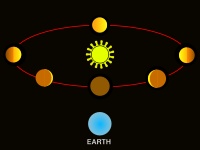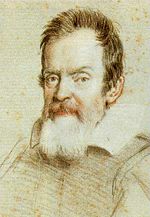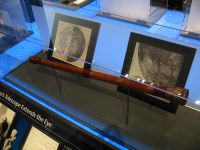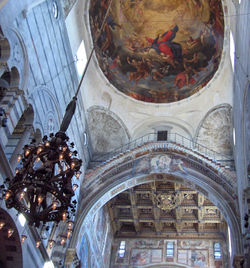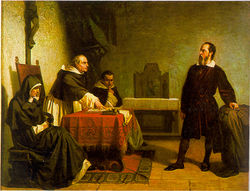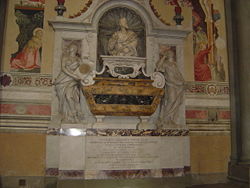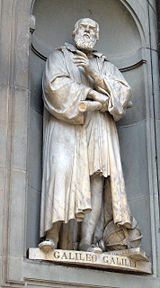Galileo Galilei
2008/9 Schools Wikipedia Selection. Related subjects: Astronomers and physicists; Engineers and inventors
| Galileo Galilei | |
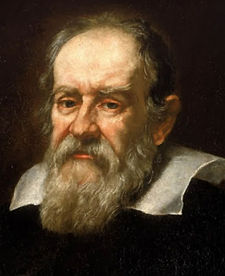 Portrait of Galileo Galilei by Giusto Sustermans
|
|
| Born | February 15, 1564 Pisa, Tuscany - Italy |
|---|---|
| Died | January 8, 1642 (aged 77) Arcetri, Tuscany - Italy |
| Residence | Grand Duchy of Tuscany |
| Fields | Astronomy, Physics and Mathematics |
| Institutions | University of Padua |
| Alma mater | University of Pisa |
| Known for | Kinematics Telescope Solar System |
| Religious stance | Roman Catholic |
Galileo Galilei ( 15 February 1564 – 8 January 1642) was a Tuscan ( Italian) physicist, mathematician, astronomer, and philosopher who played a major role in the scientific revolution. His achievements include improvements to the telescope and consequent astronomical observations, and support for Copernicanism. Galileo has been called the "father of modern observational astronomy", the "father of modern physics", the "father of science", and “the Father of Modern Science.” The motion of uniformly accelerated objects, taught in nearly all high school and introductory college physics courses, was studied by Galileo as the subject of kinematics. His contributions to observational astronomy include the discovery of the four largest satellites of Jupiter, named the Galilean moons in his honour, and the observation and analysis of sunspots. Galileo also worked in applied science and technology, improving compass design.
Galileo's championing of Copernicanism was controversial within his lifetime. The geocentric view had been dominant since the time of Aristotle, and the controversy engendered by Galileo's opposition to this view resulted in the Catholic Church's prohibiting the advocacy of heliocentrism as potentially factual, because that theory had no decisive proof and was contrary to the literal meaning of Scripture. Galileo was eventually forced to recant his heliocentrism and spent the last years of his life under house arrest on orders of the Inquisition.
Life
Galileo was born in Pisa (then part of the Grand Duchy of Tuscany), the first of six children of Vincenzo Galilei, a famous lutenist and music theorist, and Giulia Ammannati. At the age of 8, his family moved to Florence, but he was left with Jacopo Borghini for two years. He then was educated in the Camaldolese Monastery at Vallombrosa, 21 mi southeast of Florence. Although he seriously considered the priesthood as a young man, he enrolled for a medical degree at the University of Pisa at his father's urging. He did not complete this degree, but instead studied mathematics. In 1589, he was appointed to the chair of mathematics in Pisa. In 1591 his father died and he was entrusted with the care of his younger brother Michelagnolo. In 1592, he moved to the University of Padua, teaching geometry, mechanics, and astronomy until 1610. During this period Galileo made significant discoveries in both pure science (for example, kinematics of motion, and astronomy) and applied science (for example, strength of materials, improvement of the telescope). His multiple interests included the study of astrology, which in pre-modern disciplinary practice was seen as correlated to the studies of mathematics and astronomy.
Although a devout Roman Catholic, Galileo fathered three children out of wedlock with Marina Gamba. They had two daughters, Virginia in 1600 and Livia in 1601, and one son, Vincenzio, in 1606. Because of their illegitimate birth, their father considered the girls unmarriageable. Their only worthy alternative was the religious life. Both girls were sent to the convent of San Matteo in Arcetri and remained there for the rest of their lives. Virginia took the name Maria Celeste upon entering the convent. She died on April 2, 1634, and is buried with Galileo at the Basilica di Santa Croce di Firenze. Livia took the name Sister Arcangela and was ill for most of her life. Vincenzio was later legitimized and married Sestilia Bocchineri.
In 1610 Galileo published an account of his telescopic observations of the moons of Jupiter, using this observation to argue in favour of the sun-centered, Copernican theory of the universe against the dominant earth-centered Ptolemaic and Aristotelian theories. The next year Galileo visited Rome in order to demonstrate his telescope to the influential philosophers and mathematicians of the Jesuit Collegio Romano, and to let them see with their own eyes the reality of the four moons of Jupiter. While in Rome he was also made a member of the Accademia dei Lincei.
In 1612, opposition arose to the Sun-centered solar system which Galileo supported. In 1614, from the pulpit of Santa Maria Novella, Father Tommaso Caccini (1574–1648) denounced Galileo's opinions on the motion of the Earth, judging them dangerous and close to heresy. Galileo went to Rome to defend himself against these accusations, but, in 1616, Cardinal Roberto Bellarmino personally handed Galileo an admonition enjoining him neither to advocate nor teach Copernican astronomy. During 1621 and 1622 Galileo wrote his first book, The Assayer (Il Saggiatore), which was approved and published in 1623. In 1630, he returned to Rome to apply for a license to print the Dialogue Concerning the Two Chief World Systems, published in Florence in 1632. In October of that year, however, he was ordered to appear before the Holy Office in Rome.
Following a papal trial in which he was found vehemently suspect of heresy, Galileo was placed under house arrest and his movements restricted by the Pope. From 1634 onward he stayed at his country house at Arcetri, outside of Florence. He went completely blind in 1638 and was suffering from a painful hernia and insomnia, so he was permitted to travel to Florence for medical advice. He continued to receive visitors until 1642, when, after suffering fever and heart palpitations, he passed away.
Scientific methods
Galileo Galilei pioneered the use of quantitative experiments whose results could be analyzed with mathematical precision. More typical of science at the time were the qualitative studies of William Gilbert, on magnetism and electricity. Galileo's father, Vincenzo Galilei, a lutenist and music theorist, had performed experiments establishing perhaps the oldest known non-linear relation in physics: for a stretched string, the pitch varies as the square root of the tension. These observations lay within the framework of the Pythagorean tradition of music, well-known to instrument makers, which included the fact that subdividing a string by a whole number produces a harmonious scale. Thus, a limited amount of mathematics had long related music and physical science, and young Galileo could see his own father's observations expand on that tradition.
Galileo is perhaps the first to clearly state that the laws of nature are mathematical. In The Assayer he wrote "Philosophy is written in this grand book, the universe ... It is written in the language of mathematics, and its characters are triangles, circles, and other geometric figures; ...". His mathematical analyses are a further development of a tradition employed by late scholastic natural philosophers, which Galileo learned when he studied philosophy. Although he tried to remain loyal to the Catholic Church, his adherence to experimental results, and their most honest interpretation, led to a rejection of blind allegiance to authority, both philosophical and religious, in matters of science. In broader terms, this aided to separate science from both philosophy and religion; a major development in human thought.
By the standards of his time, Galileo was often willing to change his views in accordance with observation. Philosopher of science Paul Feyerabend also noted the supposedly improper aspects of Galileo's methodology, but he argued that Galileo's methods could be justified retroactively by their results. The bulk of Feyerabend's major work, Against Method (1975), was devoted to an analysis of Galileo, using his astronomical research as a case study to support Feyerabend's own anarchistic theory of scientific method. As he put it: 'Aristotelians ... demanded strong empirical support while the Galileans were content with far-reaching, unsupported and partially refuted theories. I do not criticize them for that; on the contrary, I favour Niels Bohr's "this is not crazy enough."' In order to perform his experiments, Galileo had to set up standards of length and time, so that measurements made on different days and in different laboratories could be compared in a reproducible fashion.
Galileo showed a remarkably modern appreciation for the proper relationship between mathematics, theoretical physics, and experimental physics. He understood the parabola, both in terms of conic sections and in terms of the ordinate (y) varying as the square of the abscissa (x). Galilei further asserted that the parabola was the theoretically-ideal trajectory for uniformly accelerated motion, in the absence of friction and other disturbances. He also noted that there are limits to the validity of this theory, stating that it was appropriate only for laboratory-scale and battlefield-scale trajectories, and noting on theoretical grounds that the parabola could not possibly apply to a trajectory so large as to be comparable to the size of the planet. Thirdly, Galilei recognized that his experimental data would never agree exactly with any theoretical or mathematical form, because of the imprecision of measurement, irreducible friction, and other factors.
According to Stephen Hawking, Galileo probably bears more of the responsibility for the birth of modern science than anybody else, and Albert Einstein called him the father of modern science.
Astronomy
Contributions
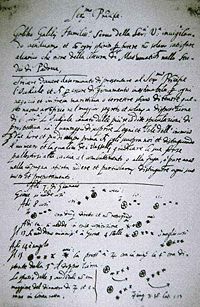
Based only on uncertain descriptions of the telescope, invented in the Netherlands in 1608, Galileo, in that same year, made a telescope with about 3x magnification, and later made others with up to about 32x magnification. With this improved device he could see magnified, upright images on the earth - it was what is now known as a terrestrial telescope, or spyglass. He could also use it to observe the sky; for a time he was one of very few who could construct telescopes good enough for that purpose. On 25 August 1609, he demonstrated his first telescope to Venetian lawmakers. His work on the device made for a profitable sideline with merchants who found it useful for their shipping businesses and trading issues. He published his initial telescopic astronomical observations in March 1610 in a short treatise entitled Sidereus Nuncius (Starry Messenger).
On January 7, 1610 Galileo observed with his telescope what he described at the time as "three fixed stars, totally invisible by their smallness", all within a short distance of Jupiter, and lying on a straight line through it. Observations on subsequent nights showed that the positions of these "stars" relative to Jupiter were changing in a way that would have been inexplicable if they had really been fixed stars. On January 10 Galileo noted that one of them had disappeared, an observation which he attributed to its being hidden behind Jupiter. Within a few days he concluded that they were orbiting Jupiter: he had discovered three of Jupiter's four largest satellites (moons): Io, Europa, and Callisto. He discovered the fourth, Ganymede, on January 13. Galileo named the four satellites he had discovered Medicean stars, in honour of his future patron, Cosimo II de' Medici, Grand Duke of Tuscany, and Cosimo's three brothers. Later astronomers, however, renamed them Galilean satellites in honour of Galileo himself.
A planet with smaller planets orbiting it was problematic for the orderly, comprehensive picture of the geocentric model of the universe, in which everything was supposed to circle around the Earth. As a consequence, many astronomers and philosophers initially refused to believe that Galileo could have discovered such a thing.
Galileo continued to observe the satellites over the next eighteen months, and by mid 1611 he had obtained remarkably accurate estimates for their periods—a feat which Kepler had believed impossible.
From September 1610, Galileo observed that Venus exhibited a full set of phases similar to that of the Moon. The heliocentric model of the solar system developed by Nicolaus Copernicus predicted that all phases would be visible since the orbit of Venus around the Sun would cause its illuminated hemisphere to face the Earth when it was on the opposite side of the Sun and to face away from the Earth when it was on the Earth-side of the Sun. In contrast, the geocentric model of Ptolemy predicted that only crescent and new phases would be seen, since Venus was thought to remain between the Sun and Earth during its orbit around the Earth. Galileo's observations of the phases of Venus proved that it orbited the Sun and lent support to (but did not prove) the heliocentric model. However, since it refuted the Ptolemaic pure geocentric planetary model, it seems it was the crucial observation that caused the 17th century majority conversion of the scientific community to geoheliocentric geocentric models such as the Tychonic and Capellan models, and was thereby arguably Galileo’s historically most important astronomical observation.
Galileo also observed the planet Saturn, and at first mistook its rings for planets, thinking it was a three-bodied system. When he observed the planet later, Saturn's rings were directly oriented at Earth, causing him to think that two of the bodies had disappeared. The rings reappeared when he observed the planet in 1616, further confusing him.
Galileo was one of the first Europeans to observe sunspots, although Kepler had unwittingly observed one in 1607, but mistook it for a transit of Mercury.. He also reinterpreted a sunspot observation from the time of Charlemagne, which formerly had been attributed (impossibly) to a transit of Mercury. The very existence of sunspots showed another difficulty with the unchanging perfection of the heavens posited by orthodox Aristotelian celestial physics, but their regular periodic transits also confirmed the dramatic novel prediction of Kepler's Aristotelian celestial dynamics in his 1609 Astronomia Nova that the sun rotates, which was the first successful novel prediction of post-spherist celestial physics. And the annual variations in sunspots' motions, discovered by Francesco Sizzi and others in 1612-1613, provided a powerful argument against both the Ptolemaic system and the geoheliocentric system of Tycho Brahe.A dispute over priority in the discovery of sunspots, and in their interpretation, led Galileo to a long and bitter feud with the Jesuit Christoph Scheiner; in fact, there is little doubt that both of them were beaten by David Fabricius and his son Johannes, looking for confirmation of Kepler's prediction of the sun's rotation. Scheiner quickly adopted Kepler's 1615 proposal of the modern telescope design, which gave larger magnification at the cost of inverted images; Galileo apparently never changed to Kepler's design.
Galileo was the first to report lunar mountains and craters, whose existence he deduced from the patterns of light and shadow on the Moon's surface. He even estimated the mountains' heights from these observations. This led him to the conclusion that the Moon was "rough and uneven, and just like the surface of the Earth itself," rather than a perfect sphere as Aristotle had claimed. Galileo observed the Milky Way, previously believed to be nebulous, and found it to be a multitude of stars packed so densely that they appeared to be clouds from Earth. He located many other stars too distant to be visible with the naked eye. Galileo also observed the planet Neptune in 1612, but did not realize that it was a planet and took no particular notice of it. It appears in his notebooks as one of many unremarkable dim stars.
Controversy over comets and The Assayer
In 1619, Galileo became embroiled in a controversy with Father Orazio Grassi, professor of mathematics at the Jesuit Collegio Romano. It began as a dispute over the nature of comets, but by the time Galileo had published The Assayer (Il Saggiatore) in 1623, his last salvo in the dispute, it had become a much wider argument over the very nature of Science itself. Because The Assayer contains such a wealth of Galileo's ideas on how Science should be practised, it has been referred to as his scientific manifesto.
Early in 1619, Father Grassi had anonymously published a pamphlet, An Astronomical Disputation on the Three Comets of the Year 1618, which discussed the nature of a comet that had appeared late in November of the previous year. Grassi concluded that the comet was a fiery body which had moved along a segment of a great circle at a constant distance from the earth, and that it had been located well beyond the moon.
Grassi's arguments and conclusions were criticised in a subsequent article, Discourse on the Comets, published under the name of one of Galileo's disciples, a Florentine lawyer named Mario Guiducci, although it had been largely written by Galileo himself. Galileo and Guiducci offered no definitive theory of their own on the nature of comets, although they did present some tentative conjectures which we now know to be mistaken.
In its opening passage, Galileo and Guiducci's Discourse gratuitously insulted the Jesuit Christopher Scheiner, and various uncomplimentary remarks about the professors of the Collegio Romano were scattered throughout the work. The Jesuits were offended, and Grassi soon replied with a polemical tract of his own, The Astronomical and Philosophical Balance, under the pseudonym Lotario Sarsi Sigenzano (an anagram of his full name), purporting to be one of his own pupils.
The Assayer was Galileo's devastating reply to the Astronomical Balance. It has been widely regarded as a masterpiece of polemical literature, in which "Sarsi's" arguments are subjected to withering scorn. It was greeted with wide acclaim, and particularly pleased the new pope, Urban VIII, to whom it had been dedicated.
Galileo's dispute with Grassi permanently alienated many of the Jesuits who had previously been sympathetic to his ideas, and Galileo and his friends were convinced that these Jesuits were responsible for bringing about his later condemnation. The evidence for this is at best equivocal, however.
Galileo, Kepler and theories of tides
Cardinal Bellarmine had written in 1615 that the Copernican system could not be defended without "a true physical demonstration that the sun does not circle the earth but the earth circles the sun". Galileo considered his theory of the tides to provide the required physical proof of the motion of the earth. This theory was so important to Galileo that he originally intended to entitle his Dialogue on the Two Chief World Systems the Dialogue on the Ebb and Flow of the Sea. For Galileo, the tides were caused by the sloshing back and forth of water in the seas as a point on the Earth's surface speeded up and slowed down because of the Earth's rotation on its axis and revolution around the Sun. Galileo circulated his first account of the tides in 1616, addressed to Cardinal Orsini.
If this theory were correct, there would be only one high tide per day. Galileo and his contemporaries were aware of this inadequacy because there are two daily high tides at Venice instead of one, about twelve hours apart. Galileo dismissed this anomaly as the result of several secondary causes, including the shape of the sea, its depth, and other factors. Against the assertion that Galileo was deceptive in making these arguments, Albert Einstein expressed the opinion that Galileo developed his "fascinating arguments" and accepted them uncritically out of a desire for physical proof of the motion of the Earth.
Galileo dismissed as a "useless fiction" the idea, held by his contemporary Johannes Kepler, that the moon caused the tides. Galileo also refused to accept Kepler's elliptical orbits of the planets, considering the circle the "perfect" shape for planetary orbits.
Technology
Galileo made a number of contributions to what is now known as technology, as distinct from pure physics, and suggested others. This is not the same distinction as made by Aristotle, who would have considered all Galileo's physics as techne or useful knowledge, as opposed to episteme, or philosophical investigation into the causes of things. Between 1595–1598, Galileo devised and improved a Geometric and Military Compass suitable for use by gunners and surveyors. This expanded on earlier instruments designed by Niccolò Tartaglia and Guidobaldo del Monte. For gunners, it offered, in addition to a new and safer way of elevating cannons accurately, a way of quickly computing the charge of gunpowder for cannonballs of different sizes and materials. As a geometric instrument, it enabled the construction of any regular polygon, computation of the area of any polygon or circular sector, and a variety of other calculations. About 1593, Galileo constructed a thermometer, using the expansion and contraction of air in a bulb to move water in an attached tube.
In 1609, Galileo was among the first to use a refracting telescope as an instrument to observe stars, planets or moons. Galileo's telescope was the first instrument given that name by an unidentified Greek poet/theologian, present at a banquet held in 1611 by Prince Federico Cesi to make Galileo a member of his Accademia dei Lincei. The name was derived from the Greek tele = 'far' and skopein = 'to look or see'. In 1610, he used a telescope at close range to magnify the parts of insects. By 1624 he had perfected a compound microscope. He gave one of these instruments to Cardinal Zollern in May of that year for presentation to the Duke of Bavaria, and in September he sent another to Prince Cesi.. The Linceans played a role again in naming the "microscope" a year later when fellow academy member Giovanni Faber coined the word for Galileo's invention from the Greek words μικρόν (micron) meaning "small", and σκοπεῖν (skopein) meaning "to look at". The word was meant to be analogous with "telescope". Illustrations of insects made using one of Galileo's microscopes, and published in 1625, appear to have been the first clear documentation of the use of a compound microscope.
In 1612, having determined the orbital periods of Jupiter's satellites, Galileo proposed that with sufficiently accurate knowledge of their orbits one could use their positions as a universal clock, and this would make possible the determination of longitude. He worked on this problem from time to time during the remainder of his life; but the practical problems were severe. The method was first successfully applied by Giovanni Domenico Cassini in 1681 and was later used extensively for large land surveys; this method, for example, was used by Lewis and Clark. For sea navigation, where delicate telescopic observations were more difficult, the longitude problem eventually required development of a practical portable marine chronometer, such as that of John Harrison.
In his last year, when totally blind, he designed an escapement mechanism for a pendulum clock, a vectorial model of which may be seen here. The first fully operational pendulum clock was made by Christiaan Huygens in the 1650s. Galilei created sketches of various inventions, such as a candle and mirror combination to reflect light throughout a building, an automatic tomato picker, a pocket comb that doubled as an eating utensil, and what appears to be a ballpoint pen.
Physics
| Classical mechanics | ||||||||
 Newton's Second Law |
||||||||
History of ...
|
||||||||
Galileo's theoretical and experimental work on the motions of bodies, along with the largely independent work of Kepler and René Descartes, was a precursor of the classical mechanics developed by Sir Isaac Newton. He was a pioneer, at least in the European tradition, in performing rigorous experiments and insisting on a mathematical description of the laws of nature.
A biography by Galileo's pupil Vincenzo Viviani stated that Galileo had dropped balls of the same material, but different masses, from the Leaning Tower of Pisa to demonstrate that their time of descent was independent of their mass. This was contrary to what Aristotle had taught: that heavy objects fall faster than lighter ones, in direct proportion to weight. While this story has been retold in popular accounts, it is generally accepted by historians that there is no account by Galileo himself of such an experiment, and that it was at most a thought experiment which did not actually take place. However, Galileo did perform experiments which proved the same thing by rolling balls down inclined planes: falling or rolling objects (rolling is a slower version of falling, as long as the distribution of mass in the objects is the same) are accelerated independently of their mass. Galileo was the first person to demonstrate this via experiment, but he was not—contrary to popular belief—the first to argue that it was true. A number of scholars prior to Galileo wrote -- or showed by experiment -- that in a vacuum, bodies which are composed of the same substance but which have different masses, fall through equal distances in equal times: Lucretius (ca. 99 - ca. 55 B.C.E., Roman poet), John Philoponus (ca. 490 - ca. 570 C.E., Greek philosopher in Alexandria, Egypt), Thomas Bradwardine (ca. 1290 - 1349, scholar at Merton College of Oxford University), Albert of Saxony (1316 - 1390, German cleric and philosopher), Pietro Monte (a.k.a. Petrus Montius, ca. 1457 - 1530, Spanish master at arms who resided in N. Italy), Benedetto Varchi (1502/3 - 1565, Italian historian and poet), Domingo de Soto (1494 - 1560, Spanish cleric and theologian), Giambattista Benedetti (1530 - 1590, Venetian mathematician), Giuseppe Moletti (1531 - 1588, Italian mathematician), and Simon Stevin (1548/9 - 1620, Flemish engineer and mathematician).
Galileo arrived at the correct mathematical law for uniform acceleration: the total distance covered, starting from rest, is proportional to the square of the time ( ), already discovered by Domingo de Soto in the 16th century He expressed this law using geometrical constructions and mathematically-precise words, adhering to the standards of the day. (It remained for others to re-express the law in algebraic terms). But he erroneously claimed gravitational free-fall universally is uniformly accelerated as the fundamental law of motion of his cosmology and cosmogony, a claim that was never generally accepted and soon refuted by the 1660s discovery that it is exponentially increasingly accelerated (a difform motion in scholastic terms) and inversely proportional to distance from its gravitational centre. He also concluded that objects retain their velocity unless a force—often friction—acts upon them, refuting the generally accepted Aristotelian hypothesis that objects "naturally" slow down and stop unless a force acts upon them (philosophical ideas relating to inertia had been proposed by Ibn al-Haytham centuries earlier, as had Jean Buridan, and according to Joseph Needham, Mo Tzu had proposed it centuries before either of them, but this was the first time that it had been mathematically expressed, verified experimentally, and introduced the idea of frictional force, the key breakthrough in validating inertia). Galileo's Principle of Inertia stated: "A body moving on a level surface will continue in the same direction at constant speed unless disturbed." This principle was incorporated into Newton's laws of motion (first law).
), already discovered by Domingo de Soto in the 16th century He expressed this law using geometrical constructions and mathematically-precise words, adhering to the standards of the day. (It remained for others to re-express the law in algebraic terms). But he erroneously claimed gravitational free-fall universally is uniformly accelerated as the fundamental law of motion of his cosmology and cosmogony, a claim that was never generally accepted and soon refuted by the 1660s discovery that it is exponentially increasingly accelerated (a difform motion in scholastic terms) and inversely proportional to distance from its gravitational centre. He also concluded that objects retain their velocity unless a force—often friction—acts upon them, refuting the generally accepted Aristotelian hypothesis that objects "naturally" slow down and stop unless a force acts upon them (philosophical ideas relating to inertia had been proposed by Ibn al-Haytham centuries earlier, as had Jean Buridan, and according to Joseph Needham, Mo Tzu had proposed it centuries before either of them, but this was the first time that it had been mathematically expressed, verified experimentally, and introduced the idea of frictional force, the key breakthrough in validating inertia). Galileo's Principle of Inertia stated: "A body moving on a level surface will continue in the same direction at constant speed unless disturbed." This principle was incorporated into Newton's laws of motion (first law).
Galileo also claimed (incorrectly) that a pendulum's swings always take the same amount of time, independently of the amplitude. That is, that a simple pendulum is isochronous. It is popularly believed that he came to this conclusion by watching the swings of the bronze chandelier in the cathedral of Pisa, using his pulse to time it. It appears however, that he conducted no experiments because the claim is true only of infinitesimally small swings as discovered by Christian Huygens. Galileo's son, Vincenzo, sketched a clock based on his father's theories in 1642. The clock was never built and, because of the large swings required by its verge escapement, would have been a poor timekeeper. (See Technology above.)
In 1638 Galileo described an experimental method to measure the speed of light by arranging that two observers, each having lanterns equipped with shutters, observe each other's lanterns at some distance. The first observer opens the shutter of his lamp, and, the second, upon seeing the light, immediately opens the shutter of his own lantern. The time between the first observer's opening his shutter and seeing the light from the second observer's lamp indicates the time it takes light to travel back and forth between the two observers. Galileo reported that when he tried this at a distance of less than a mile, he was unable to determine whether or not the light appeared instantaneously. Sometime between Galileo's death and 1667, the members of the Florentine Accademia del Cimento repeated the experiment over a distance of about a mile and obtained a similarly inconclusive result.
Galileo is lesser known for, yet still credited with, being one of the first to understand sound frequency. By scraping a chisel at different speeds, he linked the pitch of the sound produced to the spacing of the chisel's skips, a measure of frequency.
In his 1632 Dialogue Galileo presented a physical theory to account for tides, based on the motion of the Earth. If correct, this would have been a strong argument for the reality of the Earth's motion. In fact, the original title for the book described it as a dialogue on the tides; the reference to tides was removed by order of the Inquisition. His theory gave the first insight into the importance of the shapes of ocean basins in the size and timing of tides; he correctly accounted, for instance, for the negligible tides halfway along the Adriatic Sea compared to those at the ends. As a general account of the cause of tides, however, his theory was a failure. Kepler and others correctly associated the Moon with an influence over the tides, based on empirical data; a proper physical theory of the tides, however, was not available until Newton.
Galileo also put forward the basic principle of relativity, that the laws of physics are the same in any system that is moving at a constant speed in a straight line, regardless of its particular speed or direction. Hence, there is no absolute motion or absolute rest. This principle provided the basic framework for Newton's laws of motion and is central to Einstein's special theory of relativity.
Mathematics
While Galileo's application of mathematics to experimental physics was innovative, his mathematical methods were the standard ones of the day. The analysis and proofs relied heavily on the Eudoxian theory of proportion, as set forth in the fifth book of Euclid's Elements. This theory had become available only a century before, thanks to accurate translations by Tartaglia and others; but by the end of Galileo's life it was being superseded by the algebraic methods of Descartes.
Galileo produced one piece of original and even prophetic work in mathematics: Galileo's paradox, which shows that there are as many perfect squares as there are whole numbers, even though most numbers are not perfect squares. Such seeming contradictions were brought under control 250 years later in the work of Georg Cantor.
Church controversy
Western Christian biblical references Psalm 93:1, Psalm 96:10, and 1 Chronicles 16:30 include text stating that "the world is firmly established, it cannot be moved." In the same tradition, Psalm 104:5 says, " the LORD set the earth on its foundations; it can never be moved." Further, Ecclesiastes 1:5 states that "And the sun rises and sets and returns to its place, etc."
Galileo defended heliocentrism, and claimed it was not contrary to those Scripture passages. He took Augustine's position on Scripture: not to take every passage literally, particularly when the scripture in question is a book of poetry and songs, not a book of instructions or history. The writers of the Scripture wrote from the perspective of the terrestrial world, and from that vantage point the sun does rise and set. In fact, it is the earth's rotation which gives the impression of the sun in motion across the sky.
By 1616 the attacks on Galileo had reached a head, and he went to Rome to try to persuade the Church authorities not to ban his ideas. In the end, Cardinal Bellarmine, acting on directives from the Inquisition, delivered him an order not to "hold or defend" the idea that the Earth moves and the Sun stands still at the centre. The decree did not prevent Galileo from discussing heliocentrism hypothetically. For the next several years Galileo stayed well away from the controversy. He revived his project of writing a book on the subject, encouraged by the election of Cardinal Barberini as Pope Urban VIII in 1623. Barberini was a friend and admirer of Galileo, and had opposed the condemnation of Galileo in 1616. The book, Dialogue Concerning the Two Chief World Systems, was published in 1632, with formal authorization from the Inquisition and papal permission.
Pope Urban VIII personally asked Galileo to give arguments for and against heliocentrism in the book, and to be careful not to advocate heliocentrism. He made another request, that his own views on the matter be included in Galileo's book. Only the latter of those requests was fulfilled by Galileo. Whether unknowingly or deliberate, Simplicius, the defender of the Aristotelian Geocentric view in Dialogue Concerning the Two Chief World Systems, was often caught in his own errors and sometimes came across as a fool. This fact made Dialogue Concerning the Two Chief World Systems appear as an advocacy book; an attack on Aristotelian geocentrism and defense of the Copernican theory. To add insult to injury, Galileo put the words of Pope Urban VIII into the mouth of Simplicius. Most historians agree Galileo did not act out of malice and felt blindsided by the reaction to his book. However, the Pope did not take the suspected public ridicule lightly, nor the blatant bias. Galileo had alienated one of his biggest and most powerful supporters, the Pope, and was called to Rome to defend his writings.
With the loss of many of his defenders in Rome because of Dialogue Concerning the Two Chief World Systems, Galileo was ordered to stand trial on suspicion of heresy in 1633. The sentence of the Inquisition was in three essential parts:
- Galileo was required to abjure the opinion that the Sun lies motionless at the centre of the universe, and that the Earth is not at its centre and moves; the idea that the Sun is stationary was condemned as "formally heretical." However, while there is no doubt that Pope Urban VIII and the vast majority of Church officials did not believe in heliocentrism, heliocentrism was never formally or officially condemned by the Catholic Church, except insofar as it held (for instance, in the formal condemnation of Galileo) that "The proposition that the sun is in the centre of the world and immovable from its place is absurd, philosophically false, and formally heretical; because it is expressly contrary to Holy Scriptures", and the converse as to the Sun's not revolving around the Earth.
- He was ordered imprisoned; the sentence was later commuted to house arrest.
- His offending Dialogue was banned; and in an action not announced at the trial, publication of any of his works was forbidden, including any he might write in the future.
According to popular legend, after recanting his theory that the Earth moved around the Sun, Galileo allegedly muttered the rebellious phrase And yet it moves, but there is no evidence that he actually said this or anything similarly impertinent.
After a period with the friendly Ascanio Piccolomini (the Archbishop of Siena), Galileo was allowed to return to his villa at Arcetri near Florence, where he spent the remainder of his life under house arrest, and where he later became blind. It was while Galileo was under house arrest that he dedicated his time to one of his finest works, Two New Sciences. Here he summarized work he had done some forty years earlier, on the two sciences now called kinematics and strength of materials. This book has received high praise from both Sir Isaac Newton and Albert Einstein. As a result of this work, Galileo is often called, the "father of modern physics".
Galileo died on January 8, 1642. The Grand Duke of Tuscany, Ferdinando II, wished to bury him in the main body of the Basilica of Santa Croce, next to the tombs of his father and other ancestors, and to erect a marble mausoleum in his honour. These plans were scrapped, however, after Pope Urban VIII and his nephew, Cardinal Francesco Barberini, protested. He was instead buried in a small room next to the novices' chapel at the end of a corridor from the southern transept of the basilica to the sacristy. He was reburied in the main body of the basilica in 1737 after a monument had been erected there in his honour.
The Inquisition's ban on reprinting Galileo's works was lifted in 1718 when permission was granted to publish an edition of his works (excluding the condemned Dialogue) in Florence. In 1741 Pope Benedict XIV authorized the publication of an edition of Galileo's complete scientific works which included a mildly censored version of the Dialogue. In 1758 the general prohibition against works advocating heliocentrism was removed from the Index of prohibited books, although the specific ban on uncensored versions of the Dialogue and Copernicus's De Revolutionibus remained. All traces of official opposition to heliocentrism by the Church disappeared in 1835 when these works were finally dropped from the Index.
In 1939 Pope Pius XII, in his first speech to the Pontifical Academy of Sciences, within a few months of his election to the papacy, described Galileo as being among the "most audacious heroes of research ... not afraid of the stumbling blocks and the risks on the way, nor fearful of the funereal monuments" His close advisor of 40 years, Professor Robert Leiber wrote: "Pius XII was very careful not to close any doors (to science) prematurely. He was energetic on this point and regretted that in the case of Galileo."
On February 15, 1990, in a speech delivered at the Sapienza University of Rome, Cardinal Ratzinger cited some current views on the Galileo affair as forming what he called "a symptomatic case that permits us to see how deep the self-doubt of the modern age, of science and technology goes today." Some of the views he cited were those of the philosopher Paul Feyerabend, whom he quoted as saying “The Church at the time of Galileo kept much more closely to reason than did Galileo himself, and she took into consideration the ethical and social consequences of Galileo's teaching too. Her verdict against Galileo was rational and just and the revision of this verdict can be justified only on the grounds of what is politically opportune.” The Cardinal did not clearly indicate whether he agreed or disagreed with Feyerabend's assertions. He did, however, say "It would be foolish to construct an impulsive apologetic on the basis of such views".
On 31 October 1992, Pope John Paul II expressed regret for how the Galileo affair was handled, and officially conceded that the Earth was not stationary, as the result of a study conducted by the Pontifical Council for Culture.
His writings
- The Little Balance (1586)
- The Starry Messenger (1610; in Latin, Sidereus Nuncius)
- Letters on Sunspots (1613)
- Letter to the Grand Duchess Christina (1615; published in 1636)
- Discourse on the Tides (1616; in Italian, Discorso del flusso e reflusso del mare)
- Discourse on the Comets (1619; in Italian, Discorso Delle Comete)
- The Assayer (1623; in Italian, Il Saggiatore)
- Dialogue Concerning the Two Chief World Systems (1632; in Italian Dialogo dei due massimi sistemi del mondo)
- Discourses and Mathematical Demonstrations Relating to Two New Sciences (1638; in Italian, Discorsi e Dimostrazioni Matematiche, intorno a due nuove scienze)
Legacy
- The four large moons of Jupiter discovered by Galileo ( Io, Europa, Ganymede and Callisto) are often referred to as the 'Galilean moons'.
- The Galileo spacecraft was the first spacecraft to enter orbit around Jupiter, where it investigated the planet and its moons from 1995 to 2003.
- Galileo is also the name of a proposed, European satellite navigation system.
- A transformation between inertial systems in classical mechanics is called a Galilean transformation.
- The gal, sometimes called galileo, (symbol Gal) is a non- SI unit of acceleration named after Galileo. The gal is defined as 1 centimeter per second squared (1 cm/s²).
- The United Nations scheduled the International Year of Astronomy in 2009 in part to coincide with Galileo's first recorded astronomical observations with a telescope.
In popular culture
- Singer-songwriter Ellis Paul wrote and recorded a song Did Galileo Pray. See also commentary on the song published in the June/July 2006 issue of the physics journal Symmetry.
- There is a play called Life of Galileo by the German dramatist Bertolt Brecht. It was filmed in 1975 as Galileo, with Topol in the title role, and an all-star cast.
- A play about Galileo's struggle with the Church, Lamp at Midnight, was first televised in 1966 on the Hallmark Hall of Fame, with Melvyn Douglas as Galileo and Kim Hunter as his daughter. The production also featured an appearance by Roy Scheider in an early role.
- Galileo is mentioned in Queen's song, Bohemian Rhapsody.
- The American duo Indigo Girls released a song in 1992 about the "king of night vision" whose head was "on the block." Entitled "Galileo," the song hit the #10 spot on the Billboard's Modern Rock Tracks chart, the biggest hit to date for the musical duo.
- Galileo is also the title of a song by Amy Grant.
- The Philadelphia Atmospheric Sludge Metal band named their 2005 full length "The Galilean Satellites", wherein most songs are about Jupiter and its 4 Galilean moons, specifically Europa.
- The Symphonic Metal band Haggard made an album based on the life of Galileo and the legend that he muttered the phrase Eppur si muove meaning "And yet it does move", after being forced to recant, in front of the Inquisition.
- The shuttlecraft used in the Star Trek first season episode The Galileo Seven is named after the famed astronomer. When that shuttle is destroyed at the end of the episode, another shuttlecraft is named the Galileo II.
